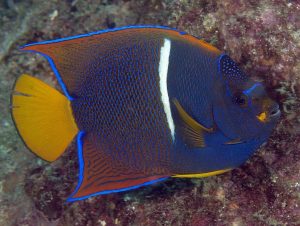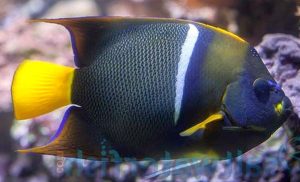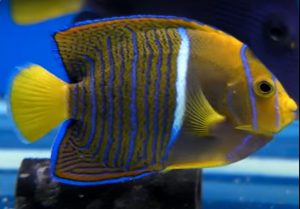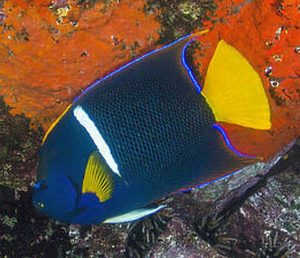The Passer Angelfish (Holacanthus passer) known to tropical fish keeping enthusiasts as the King Angelfish, are widely distributed throughout the Eastern Pacific and ranges from the Gulf of California to Peru, and as far west as the Galapagos Islands.
Passer Angelfish are frequently found hiding between large crevices, overhangs, and caves in rocky tropical reefs they frequent at depths from 12 to 100 feet. Adults prefer the middle to bottom layers of the water column where they feed on sponges, zooplankton, sessile invertebrates, tunicates, and several species of benthic microalgae. They are active during daylight hours (diurnal), but like other reef dwellers seek shelter in crevices where they reside during the night.
Juvenile Holacanthus passer are occasionally collected in tidal pools and are often found in channels, bays, and along the shallower inshore reefs where they establish cleaning stations and perform as cleaner fish, removing ectoparasites from a wide range of other fish species.
Adult Passer Angelfish have a predominately dark blue body with a white vertical stripe extending about two thirds down the body from the dorsal to the pelvic fin. The caudal, pectoral, and ventral fins on females are yellow. Males have white ventral fins with yellow caudal and pectoral fins. The dorsal fin is edged in yellow.
Male Passer angelfish are usually larger than females and have white pelvic fins. Adult females are smaller and have yellow pelvic fins.
Juvenile Passer Angelfish have more orange on the body with one bright white stripe extending from the
dorsal to the pelvic fins, and multiple bright blue stripes over the rest of the body. The caudal fin is bright orange to yellow and the pelvic fins are yellow. The fins are edged in deep blue.
Passer Angelfish are a hardy and very aggressive species. They will attack other angelfish and passive species like anthias, batfish, tilefish, butterflyfish, and stationary or slow moving species like frogfishes, lionfish, and scorpionfishes. They will also nip on sessile invertebrates, stony corals, clams, and most soft corals. They have been known to nip at the eyes of sharks, possibly mistaking them for coral polyps.
Because of their large size (over a foot in length), aggressiveness, and the fact that they are not reef safe; juvenile Passer Angelfish (Holacanthus passer) are best housed in a large fish only live rock (FOLR) aquarium of at least 150 gallon capacity, with copious amounts of aged live rock for grazing and arranged into numerous hiding places. Adults require a tank of at least 500 gallon capacity and preferably larger if you house them with other large angelfish.
Although some tropical fish keeping enthusiasts have managed to successfully house Passer Angelfish with Cladiella spp., Lamnalia spp., Litophyton spp., Sinularia spp. and other sturdy corals that produce a noxious chemical defense, reef tanks are definitely not recommended.
Passer Angelfish are aggressive enough to hold their own in a large aggressive community tank with triggerfish, puffers, groupers, and other large, aggressive species. We do not recommend attempting to keep Holacanthus passer with other large angels. They quickly become dominant and abusive to smaller or more docile tankmates, especially angelfish that are lower on the social hierarchy.
Passer angelfish have not yet been bred in captivity. In their natural habitat, breeding takes place daily at sunset from April to November, and peaks in October and November.
Passer angelfish are monogamous and at dusk, several males will congregate along the sandy bottom to wait for the arrival of the females. Each male will swim toward and above their female and flutter their bodies in short jittery motions until the female is ready to spawn. When ready, the female will rise with the male moving below her belly to nuzzle it with his nose. As the pair quiver and swim in spirals toward the surface, they simultaneously release their gametes.
During a spawning cycle a single pair can produce upwards of ten million fertilized eggs, averaging about 25,000 to 75,000 daily. The fertilized eggs drift with the current in the water column and hatch around 20 hours later. After hatching, the finless fry live off their yolk sack until it is completely absorbed, at which point they drift down to the bottom of the reef and begin to eat small zooplankton. The entire spawning event lasts for approximately 30 minutes.
In their natural habitat, Passer Angelfish feed on sponges, zooplankton, sessile invertebrates, tunicates, and benthic microalgae. In an aquarium environment with plenty of aged live rock, their diet should also include Spirulina, marine algae, Mysis shrimp
, meaty foods, and a high quality angelfish preparation that includes sponges. They do best when fed small portions at least three times daily.
Because they require sponges and tunicates as a food source and will often not accept prepared foods, even ones that contain sponges or tunicates as ingredients; Passer Angelfish have a well deserved reputation for being difficult to keep.
Passer Angelfish (Holacanthus passer) or King Angelfish are popular with tropical fish keeping enthusiasts but because of their specialized diet and large size are not common in the aquarium hobby. They can be ordered through specialty fish shops and online from a variety of sources at the following approximate purchase sizes; Juvenile: Small 1″ to 1-3/4″; Medium 1-3/4″ to 2-1/4″; Adult: Small: 1-3/4″ to 2-1/4″; Small/Medium: 2-1/4″ to 3-1/4″; Medium: 3-1/4″ to 4″; Medium/Large 4″ to 5″; Large: 5″ to 6″; XLarge: 6″ or larger.
Minimum Tank Size: 150 gallons
Aquarium Type: Mature live rock
Care Level: Moderate
Temperament: Semi-Aggressive
Aquarium Hardiness: Hardy
Water Conditions: 72 °F – 78 °F, dKH 8 to 12, pH 8.1 – 8.4, sg 1.020-1.025
Max. Size: 14″
Color Form: Blue, Yellow, White
Diet: Omnivore
Compatibility: Not reef safe
Origin: Eastern Pacific to Peru, Galapagos Islands
Family: Pomacanthidae
Lifespan: 15-20 years
Aquarist Experience Level: Expert






